Photographs: Reuters
The common man is quaking. The government is worried. And the industry is concerned, too. The reason: Deficient rainfall and soaring food prices.
With the south-west monsoon not reviving and the prices of essential commodities touching unprecedented levels, the Confederation of Indian Industry is uneasy about the possible impact on the country's economic growth.
The India Meteorological Department has said that average monsoon rainfall has been deficient by 28 per cent in the country for the period June 1 to August 9. The government has already declared 161 districts as drought-prone, with sowing across the country down by 20 per cent.
The June-September rainfall accounts for nearly 80 per cent of the annual rainfall and is essential for the economy, being the main source of water for agriculture.
Given that the economy is still at early stages of recovery from the global economic slowdown, a weak monsoon can impact the economy adversely in a number of ways.
There is a shortfall of more than 6 million hectares in sowing of rice. Also the acreage under sugarcane and oilseeds is lower than in the corresponding period last year. Read on. . .
CII's 5-point plan to counter rising prices, scanty rainfall
Image: A vendor arranges vegetables at a market.Photographs: Mukesh Gupta/Reuters
Coupled with this, there is risk of sharp upward pressure on the prices of pulses, oilseeds, sugar, fibres, eggs and meat, milk and milk products, fruit and vegetables.
This will pose a stiff challenge before the government as it tries to keep prices of these items in check in the coming months when shortages become more evident.
Rakesh Mittal, chairman, CII National Council on Agriculture, said on Thursday that "even if there is some catching up in the rainfall in remaining season of the monsoon, it would still leave the Kharif crop adversely impacted and due to late harvesting of the Kharif crop, sowing of the Rabi crop will be delayed resulting in poor productivity."
"The impact could also be felt on high value-added agricultural sectors, such as horticulture and live-stock. Export earnings may therefore witness a decrease," he added.
In light of this grave situation, the CII has suggested a 5-point agenda on the measures that need to be undertaken by central and state governments to stave off the adverse effects of a deficient monsoon. Let's find out what this agenda is. . .
CII's 5-point plan to counter rising prices, scanty rainfall
Image: A farmer walks back after a day's work.Photographs: Jayanta Dey/Reuters
1. Water Management
The vagaries of the monsoon must be countered by urgently completing all irrigation projects and focussed attention to large scale promotion of drip irrigation to conserve water.
For the long term, the government must plan for area specific water management policies, the CII has suggested.
While in the short-run various measures would be taken to ensure adequacy and price stability of food supplies, it is imperative to address some distortions in production pattern and distribution mechanism in the medium and long run if this oft-repeated saga of delayed or deficient monsoon and higher food grain prices is to be avoided.
CII's 5-point plan to counter rising prices, scanty rainfall
Image: Farmers thresh paddy in a field.Photographs: Fayaz Kabli/Reuters
2. Price Management
Proper monitoring and forecasting of weather conditions and dissemination of information to avoid speculation and hoarding is required, the industry body says.
Innovative distribution mechanisms should be adopted to facilitate quick movement of food grains. The government should allow, both, the public sector units and private traders to import food grains without duty or with reduced duty, allowing open market sale of foodgrain, free import of pulses without duty or with minimum duty.
CII's 5-point plan to counter rising prices, scanty rainfall
Image: A farmer rests on the heap of paddy.Photographs: Reuters
3. Income Stabilisation
The government's policies of stepping up allocation to various schemes that are aimed at rural India are already underway.
For example, the National Rural Employment Guarantee Scheme should work to create assets in the area of rain water harvesting, and long-term community water resources.
CII's 5-point plan to counter rising prices, scanty rainfall
Image: A Sikh farmer walks through a parched paddy field.Photographs: Dipak Kumar/Reuters
4. Weather Insurance
With growing fear of climate change turning into reality, in terms of unpredictable weather and its adverse impact especially on agricultural crops, there is a need to expand the coverage of weather insurance in India.
CII's 5-point plan to counter rising prices, scanty rainfall
Image: A labourer walks through a paddy field in the village of Bhootgarh in Punjab.Photographs: Ajay Verma/Reuters
5. Procurement Mechanism
For maintaining stock of rain-fed crops like pulses, a strong procurement mechanism is needed. There is also a strong case for a Minimum Support Price or a contract farming arrangement for rain-fed crops.
Chandrajit Banerjee, director general, CII, said that India must work for a new green revolution in pulses and oilseeds in the way it has done for rice and wheat.
Moreover, the corporate sector would be keen to be involved in making farming in the non-MSP crops more attractive. This would help increase productivity by spread of modern farm technology.

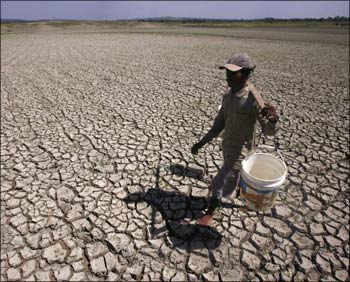
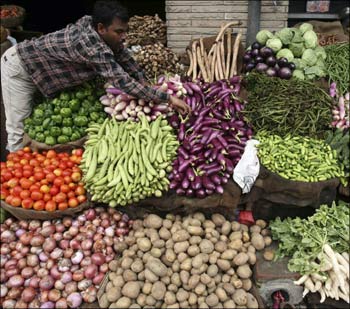

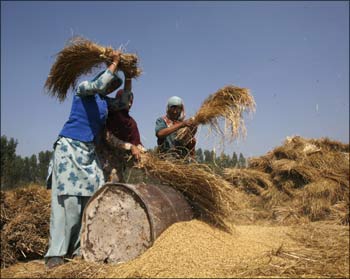

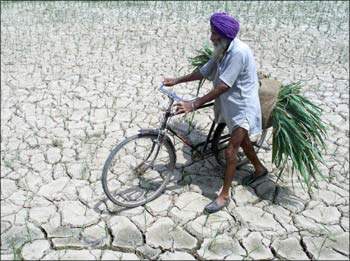
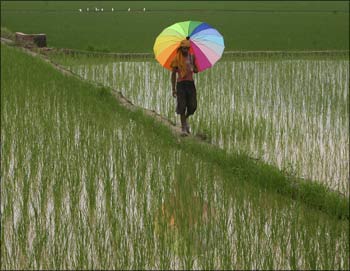
article